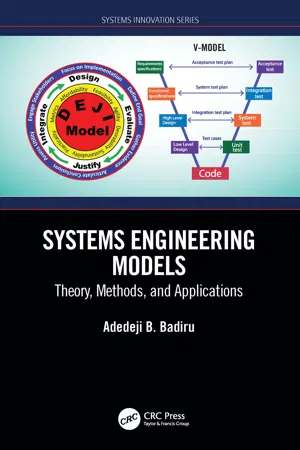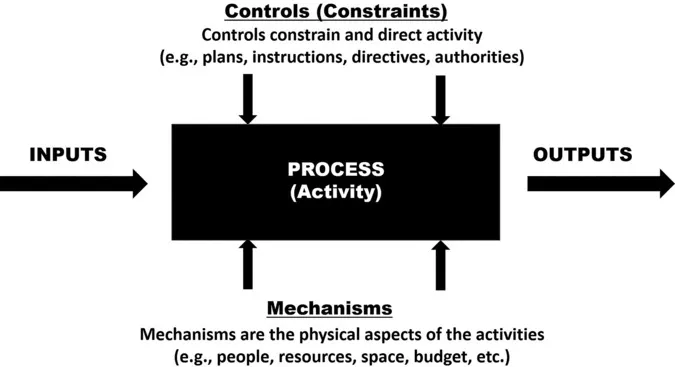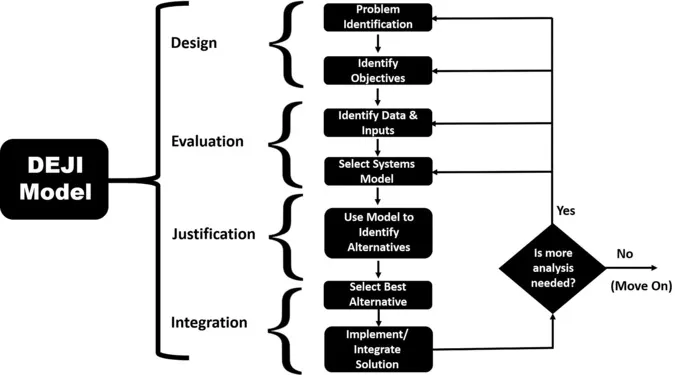
This is a test
- 208 pages
- English
- ePUB (mobile friendly)
- Available on iOS & Android
eBook - ePub
Book details
Book preview
Table of contents
Citations
About This Book
This book presents a comprehensive compilation of practical systems engineering models. The application and recognition of systems engineering is spreading rapidly, however there is no book that addresses the availability and usability of systems engineering models. Notable among the models to be included are the V-Model, DEJI Model, and Waterfall Model. There are other models developed for specific organizational needs, which will be identified and presented in a practical template so that other organizations can learn and use them. A better understanding of the models, through a comprehensive book, will make these models more visible, embraced, and applied across the spectrum.
Visit www.DEJImodel.com for model details.
Features
-
- Covers applications to both small and large problems
- Displays decomposition of complex problems into smaller manageable chunks
- Discusses direct considerations of the pertinent constraints that exist in the problem domain
- Presents systematic linking of inputs to goals and outputs
Frequently asked questions
At the moment all of our mobile-responsive ePub books are available to download via the app. Most of our PDFs are also available to download and we're working on making the final remaining ones downloadable now. Learn more here.
Both plans give you full access to the library and all of Perlego’s features. The only differences are the price and subscription period: With the annual plan you’ll save around 30% compared to 12 months on the monthly plan.
We are an online textbook subscription service, where you can get access to an entire online library for less than the price of a single book per month. With over 1 million books across 1000+ topics, we’ve got you covered! Learn more here.
Look out for the read-aloud symbol on your next book to see if you can listen to it. The read-aloud tool reads text aloud for you, highlighting the text as it is being read. You can pause it, speed it up and slow it down. Learn more here.
Yes, you can access Systems Engineering Models by Adedeji B. Badiru in PDF and/or ePUB format, as well as other popular books in Technology & Engineering & Electrical Engineering & Telecommunications. We have over one million books available in our catalogue for you to explore.
Information
chapter one
Systems introduction
Introduction
A system is represented as consisting of multiple parts, all working together for a common purpose or goal. Systems can be small or large, simple or complex. Small devices can also be considered systems. Systems have inputs, processes, and outputs. Systems are usually explained using a model for a visual clarification inputs, process, and outputs. A model helps illustrate the major elements and their relationships. Figure 1.1 illustrates the basic model structure of a system.

Figure 1.1 Systems input, process, and output structure.

Figure 1.2 Flowchart of DEJI model framework.
Systems engineering is the application of engineering tools and techniques to the solutions of multifaceted problems through a systematic collection and integration of parts of the problem with respect to the life cycle of the problem. It is the branch of engineering concerned with the development, implementation, and use of large or complex systems. It focuses on specific goals of a system considering the specifications, prevailing constraints, expected services, possible behaviors, and structure of the system. It also involves a consideration of the activities required to ensure that the system’s performance matches specified goals. Systems engineering addresses the integration of tools, people, and processes required to achieve a cost-effective and timely operation of the system. Some of the features of this book include solution to multifaceted problems; a holistic view of a problem domain; applications to both small and large problems; decomposition of complex problems into smaller manageable chunks; direct considerations for the pertinent constraints that exist in the problem domain; systematic linking of inputs to goals and outputs; explicit treatment of the integration of tools, people, and processes; and a compilation of existing systems engineering models. A typical decision support model is a representation of a system, which can be used to answer questions about the system. While systems engineering models facilitate decisions, they are not typically the conventional decision support systems.
The end result of using a Systems engineering approach is to integrate a solution into the normal organizational process. For that reason, the DEJI systems model is desired for its structured framework of Design, Evaluation, Justification, and Integration. The flowchart for this framework is shown in Figure 1.2.
INCOSE Systems Engineering Competency Framework
The International Council on Systems Engineering (INCOSE) developed the INCOSE Systems Engineering Competency Framework (INCOSE SECF), which represents a worldview of five competency groupings with 36 competencies central to the profession of systems engineering. This includes evidence-based indicators of knowledge, skills, abilities, and behaviors across five levels of proficiency. INCOSE SECF supports a wide variety of usage scenarios including individual and organizational capability assessments. It enables organizations to tailor and derive their own competency models that address their unique challenges. The five competency groupings and their respective competencies are provided below:
•Systems Engineering Management
1.Information Management
2.Planning
3.Monitoring and Control
4.Risk and Opportunity Management
5.Business and Enterprise Integration
6.Decision Management
7.Concurrent Engineering
8.Configuration Management
9.Acquisition and Supply
•Professional
1.Communications
2.Facilitation
3.Ethics and Professionalism
4.Coaching and Mentoring
5.Technical Leadership
6.Emotional Intelligence
7.Negotiation
8.Team Dynamics
•Core Systems Engineering Principles
1.General Engineering
2.Systems Thinking
3.Capability Engineering
4.Critical Thinking
5.Systems Modeling and Analysis
6.Life cycles
•Integrating
1.Quality
2.Finance
3.Project Management
4.Logistics
•Technical
1.Requirements Definition
2.Systems Architecting
3.Transition
4.Operations and Support
5.Design (for specific needs)
6.Integration
7.Interfaces
8.Verification
9.Validation
Each competency in the SECF framework has five proficiency levels as summarized below.
Awareness proficiency
The person displays knowledge of key ideas associated with the competency area and understands key issues and their implications.
Supervised practitioner proficiency
The person displays an understanding of the competency area and has some limited experience.
Practitioner
The person displays both knowledge and practical experience of the competency area and can function without supervision on a day-to-day basis.
Lead practitioner
The person displays extensive and substantial practical knowledge and experience of the competency area and provides guidance to others including practitioners encountering unusual situations.
Expert
In addition to extensive and substantial practical experience and applied knowledge of the competency area, this individual contributes to and is recognized beyond the organizational or business boundary.
It should be noted that in many professional environments, it is believed that it takes about 15 years of practical experience to become an expert in any particular professional pursuit.
Systems attributes, factors, and indicators
In any systems approach, the systems analyst must be cognizant of the attributes, factors, and indicators that fully describe the overall system. For the technical competency part of SERC, the attributes, factors, and indicators of competency...
Table of contents
- Cover
- Half Title
- Series Page
- Title Page
- Copyright Page
- Dedication Page
- Table of Contents
- Preface
- Acknowledgments
- Author
- Chapter 1 Systems introduction
- Chapter 2 Model-based systems engineering
- Chapter 3 Human Factors in systems modeling
- Chapter 4 Ergonomics in systems design and modeling
- Chapter 5 Systems theory for systems modeling
- Chapter 6 System-of-systems engineering management for systems modeling
- Chapter 7 Waterfall model, V-model, spiral model, and other SE models
- Chpater 8 The DEJI model of systems engineering
- Chapter 9 Vehicle systems modeling
- Chapter 10 Systems modeling for product design
- Chapter 11 Dynamic fuzzy systems modeling
- Index